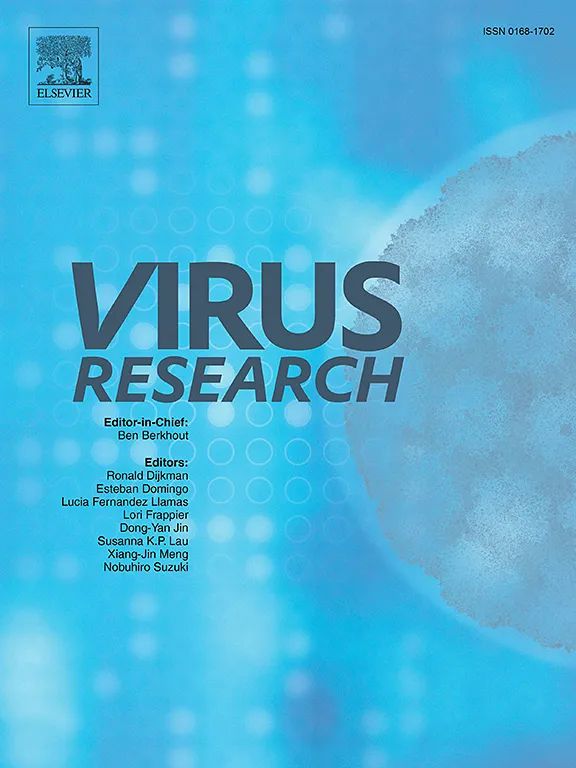Identification of H1N2 influenza viruses in turkeys after spillover from swine and in vitro characterization
IF 2.7
4区 医学
Q3 VIROLOGY
引用次数: 0
Abstract
Influenza A viruses (IAVs) circulate among animals and humans and can cross species barriers to adapt to new hosts. In France, since 2020, a new genotype named H1avN2#E has predominated in pig farms. In parallel, this virus was detected in 19 breeding turkey flocks and in a human case, indicating interspecies transmission. The objectives of this study were (i) to analyze viral sequences detected in turkeys between April 2020 and January 2023 and compare them with swine sequences to identify potential markers of adaptation and (ii) to characterize three representative viruses in vitro and in ovo on MDCK, MLE15 and A549 cells, as well as on embryonated chicken eggs. Results suggest that following initial swine-to-turkey spillovers, the virus circulated between turkey farms. Phylogenetic analyses and host origin guided the selection of three viruses: a reference swine virus (A), a turkey strain closely related to swine viruses (B) and a virus apparently circulating in turkeys (C). Three molecular markers may contribute to turkey adaptation: the E233K, under positive selection pressure, or E236K mutations in the 220-loop of the receptor-binding site of HA protein and two NA substitutions, T401N in antigenic site 2d and S416N. Replication kinetics showed that at low MOI (0.001), virus C produced more infectious particles on MDCK and A549 cells, whereas at high MOI (0.1), virus B produced more. In ovo, infectious particles were generated for viruses A and B but not efficiently for virus C, in contrast to mammalian cells where production was higher.
猪流感病毒外溢后火鸡中H1N2流感病毒的鉴定及体外鉴定。
甲型流感病毒(iav)在动物和人类之间传播,并能跨越物种障碍以适应新的宿主。在法国,自2020年以来,一种名为H1avN2#E的新基因型在养猪场占主导地位。同时,在19个养殖火鸡群和1例人间病例中发现了该病毒,表明存在种间传播。本研究的目的是:(i)分析2020年4月至2023年1月期间在火鸡中检测到的病毒序列,并将其与猪的序列进行比较,以确定潜在的适应标记;(ii)在MDCK、MLE15和A549细胞以及胚胎鸡蛋上,对三种体外和蛋内的代表性病毒进行表征。结果表明,在最初的猪对火鸡的溢出之后,病毒在火鸡养殖场之间传播。系统发育分析和宿主来源指导了三种病毒的选择:参考猪病毒(a),与猪病毒密切相关的火鸡毒株(B)和明显在火鸡中传播的病毒(C)。三种分子标记可能有助于火鸡的适应:在正选择压力下的E233K,或HA蛋白受体结合位点220环的E236K突变和两个NA替换,抗原位点2d和S416N的T401N。复制动力学表明,在低MOI(0.001)时,病毒C在MDCK和A549细胞上产生更多的感染性颗粒,而在高MOI(0.1)时,病毒B产生更多的感染性颗粒。在卵细胞中,病毒A和病毒B可以产生感染性颗粒,但病毒C不能有效地产生感染性颗粒,而哺乳动物细胞的感染性颗粒的产生率更高。
本文章由计算机程序翻译,如有差异,请以英文原文为准。
求助全文
约1分钟内获得全文
求助全文
来源期刊

Virus research
医学-病毒学
CiteScore
9.50
自引率
2.00%
发文量
239
审稿时长
43 days
期刊介绍:
Virus Research provides a means of fast publication for original papers on fundamental research in virology. Contributions on new developments concerning virus structure, replication, pathogenesis and evolution are encouraged. These include reports describing virus morphology, the function and antigenic analysis of virus structural components, virus genome structure and expression, analysis on virus replication processes, virus evolution in connection with antiviral interventions, effects of viruses on their host cells, particularly on the immune system, and the pathogenesis of virus infections, including oncogene activation and transduction.
 求助内容:
求助内容: 应助结果提醒方式:
应助结果提醒方式:


